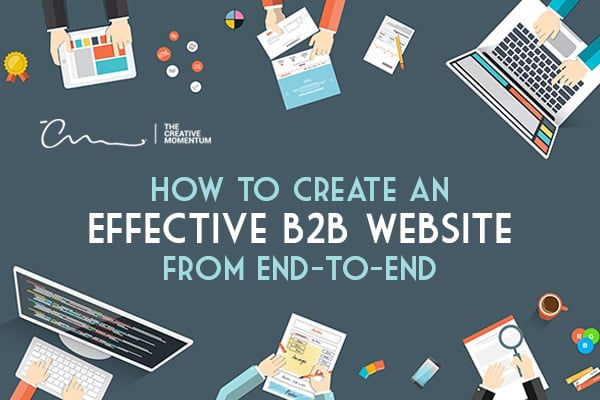 Web design can feel like a daunting task, especially if you’re trying to create a website for your business. Crafting compelling copy, and creating a website that’s both functional and inviting can feel like a tall order, especially when you want to attract other business owners. B2B audiences are traditionally savvier than general consumers.
Web design can feel like a daunting task, especially if you’re trying to create a website for your business. Crafting compelling copy, and creating a website that’s both functional and inviting can feel like a tall order, especially when you want to attract other business owners. B2B audiences are traditionally savvier than general consumers.
What’s more, these folks tend to be short on time because they, too, are running a business. As a result, your B2B website needs to be eye-pleasing, relevant, and compelling enough to generate leads. This is why building an effective B2B website requires careful consideration.
Below, we'll review everything you need to know about how to build a B2B website:
- Perform market research
- Plan a goal-oriented roadmapping process
- Design with your target audience in mind
- Consider key UI and UX elements
- Manage on-page SEO
- Conduct A/B tests
Conduct Market Research

Whether you’re just beginning to launch a website or you’re planning a redesign, you need to perform research that supports informed decisions at every step. There's simply no other way to ensure your B2B site will be effective at generating leads and priming them for entry into your marketing funnel.
This research needs to be threefold:
- Your business goals (including existing website performance, if you currently have one)
- Your target audience’s needs
- The competition
These three elements will form the foundation of your website creation efforts, from initial planning to wireframing to designing and post-launch support. Let's review each in more detail.
1. Identify Your Business Goals
(Obviously) you’re in business because you have a stellar product or service that meets the needs of a segment of the population. Most likely, you want to build your customer base, increase revenue, and maybe even expand. To steer your web design plans in the right direction, its important to drill further down into these general goals:
- Do you want your website to serve as a simple lead generator from which inquiries are handed off to a sales team?
- Would you prefer to guide your B2B visitors through a full sales cycle and convert them from prospects to customers?
The answers to these questions determines how much and what types of functionalities you’ll need. A website that simply collects consumer information for follow-up may face fewer backend or infrastructure challenges than an ecommerce store. Websites designed for sales must integrate into your existing IT strategy and manage inventory, shipping, and more.
Once you've identified all your website needs - functionality, and pages - it's time to develop a sitemap that provides a clear breakdown of every page and its function within your marketing funnel.
2. Perform an Analytics Check
If you currently have a website and are planning an update, don’t start making wish lists until you’ve evaluated your current analytics. Use analytics to avoid wasting time on updates to pages and sections that were already performing well or weren’t directly relevant to your business goals.
Similarly, if you review the data and learn that you have high rates of abandonment or low engagement on critical pages, then you can prioritize working on those pages. If you want real-time data, consider installing a “heat map” that will show you what parts of the page are getting the most interactions and drawing the most attention.
The idea here is to prevent scope creep and project bloat by learning which areas are your lowest hanging fruit that can yield big results. This will minimize project timelines and reduce the chances of disrupting established workflows in your complex sales process.
As they say, if it's ain't broke -- don't fix it.
3. Identify Your Target Audience’s Needs

Define who you’re marketing to when you build your website. B2B customers are savvier than the general public and they often don’t get to make decisions without input from other key stakeholders. In some cases, you may find that this customer must get buy-in from as many as 10 colleagues before he or she can make a purchase. In other words, B2B websites must be built with the needs of multiple stakeholders in mind.
Think about how your website will look to someone who must get approval first before taking an action. If the information isn’t compelling and doesn’t differentiate your business from the competition, that first view isn’t going to be shared with the decision-makers in a company.
Your goal here is to create a simple experience that offers a clear, logical view of what your company does, how you're different from competitors, and what actions users can take to learn more. Creating buyer personas for your ideal customers can help ensure that your development goals stay focused on the needs of those who will profit most from a partnership with your brand.
4. Performance Competitive Analysis
Keep an eye on the competition. This is just good business and serves a few key purposes. First, you can see what standard procedure is in your industry. Where are other businesses in your industry providing calls to action (CTA) to qualify leads? Are they thoughtfully priming and nurturing leads with a series of targeted lead magnets across their content? Or are they encouraging customers to fill out a lengthy quote form in order to help them move forward right away? You get great feedback on what to do as well as what not to do.
Likewise, you can determine the best way to differentiate your business from theirs by examining the value propositions they're pushing. You can also get a sense of what type of keywords they may be using to rank in organic search. This data can help you understand what aspects of your niche have the least competition, which in turn will help you fine-tune your B2B lead nurturing cycle.
Strategize Your Structural Build
Now it’s time to start putting together the structural layout for your website. As a general rule, less is more when it comes to web design. Leverage the planning you've done with your designer and keep in mind that businesses with full sales cycles versus contact-only CTAs may have different strategies.
While both will want to place a CTA on the home page, a business that’s gathering leads for future conversations needs to prioritize expertise, experience, and testimonials while it builds rapport with its audience. Whichever business model applies to you, it’s best to leverage growth-driven design (GDD) to build or update your website.
With GDD, you’re not bogged down with a traditional design plan, which can be costly, take months and still not support your business goals. Instead, you’ll identify the top 20% key priorities that must be implemented in your design plans, build it, and go live with what’s known as a launch pad website. You'll then monitor your analytics to identify and adjust underperforming parts of your website and incorporate other features over time.
1. Prioritize UX and UI
Yes, B2B customers are often savvier than their B2C counterparts, but they’re still human beings who dislike websites that are faulty or difficult to navigate. While they are more prone to discover your website through desktop, they will probably return many times through a mobile device or tablet and are also annoyed by walls of text, poor color contrasts, or websites that refresh for no reason. Make sure that your website design follows key principles for user experience (UX) and user interface (UI) to prevent forced errors.
These are essential goals for any type of website design, but in the B2B world, things get more complicated. The UX isn't just about creating a clear, uncluttered site -- it's about creating a repeatable engagement strategy that keeps buyers there long enough to gather the information you need to create a tailored sales experience.
2. Write Compelling Copy that Gets to the Point
Considering how much longer the sales cycle can be for B2B customers, your website content is critical for building rapport and convincing your audience to choose you over the competition. With that in mind, work on creating focused value propositions that directly address your market's pain points. Don't get wordy or try to wow them with jargon.
Remember, B2B buyers have been around the block and know what they're looking for. You'll impress them more with clear, focused messaging that speaks to their needs than any type of broad or unsubstantiated claims.
3. Leverage Social Currency
Unlike a B2C website, you might not be able to leverage user-generated content from social media. Instead, you can incorporate features like white papers, case studies, and testimonials. They position your business as an authority in your industry and proves that other B2B consumers trusted you. This is especially important if you offer a product or service with a long sales cycle where buyers need more time to make a purchase.
4. Incorporate SEO Best Practices
You should incorporate an SEO strategy from day one of your website design plan. You’ll want to ensure that you have an on-page and an off-page plan that increases your discoverability. On-page strategies include keyword optimization, internal linking, and metadata management. Off-page strategies generally involve acquiring high-value backlinks and building brand authority. (For more on-page or off-page SEO information, we wrote about it here.)
Your website development partner can help preserve any existing SEO value you have when updating your page, ensuring that you don't change key elements driving the majority of your SEO value. If you're starting from scratch, work with your designer to come up with a plan and don't be afraid to leverage free online SEO resources from Google to give you a place to begin.
5. Use Regular A/B Testing
A/B testing is a straightforward process where you'll compare two site elements over time to see which generates the most engagement from users (if there's any change at all). You can A/B test just about any aspect of your website, from CTA copy to UI colors to the way information is laid out.
Regular A/B testing is the best way to optimize your site over time and hammer out UI/UX problems you can't solve in the early planning stages. We've written extensively about quality A/B testing tools in the past, so if this concept is new to you, consider one of those resources as a starting point.
Build for a Unique Audience
Building a B2B website doesn’t have to be overwhelming, but it does require that you understand some general unique differences that set this demographic apart. Most importantly, create a website that can support an extended sales cycles that provides value and positions your business as an authority within your industry. It’s a challenge to incorporate all the components of a compelling, lead-generating B2B website.
The Creative Momentum knows just how to leverage a GDD strategy to build a website that can support your business goals and drive engagement with a B2B audience. If you need help throughout any aspect of the planning or development process, contact our team and we'll be happy to show you the way.


